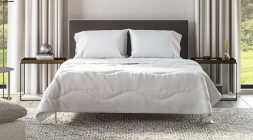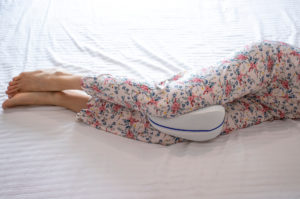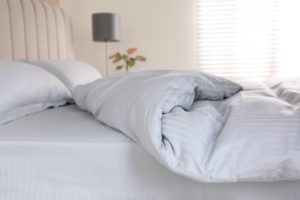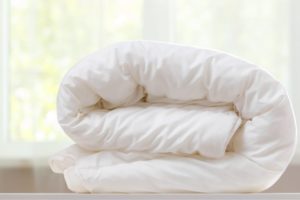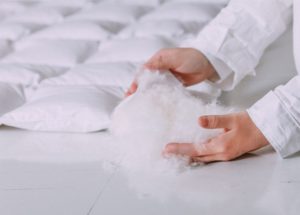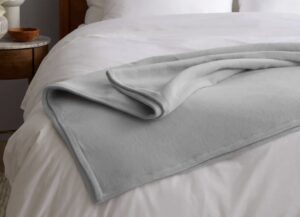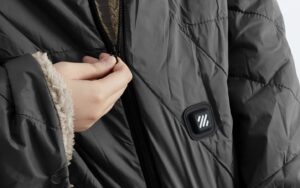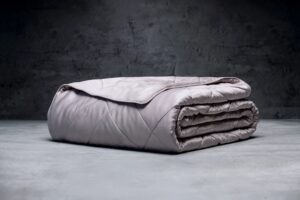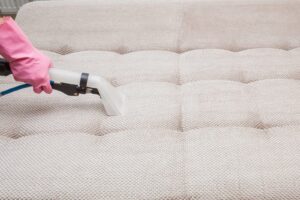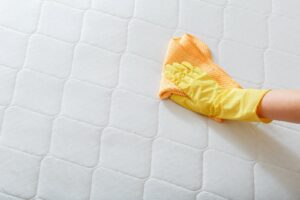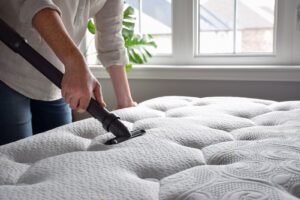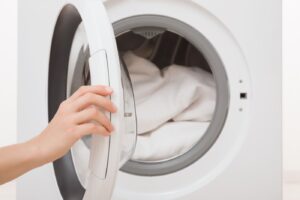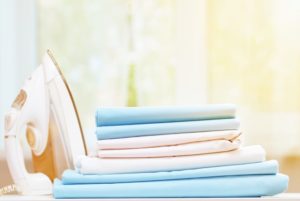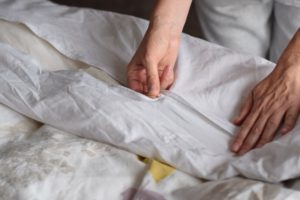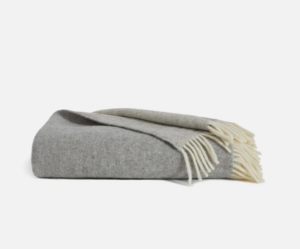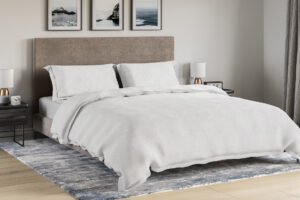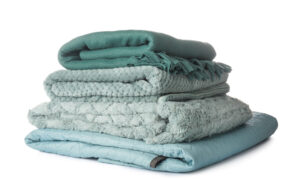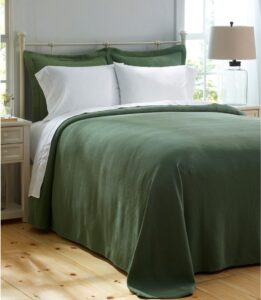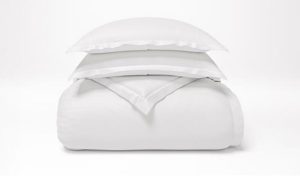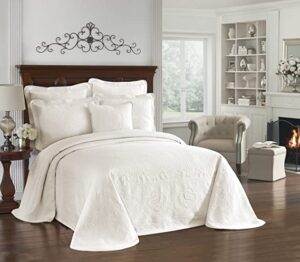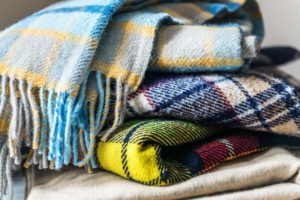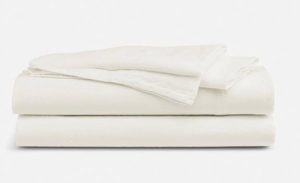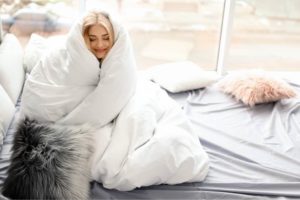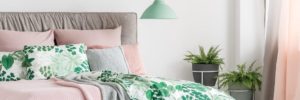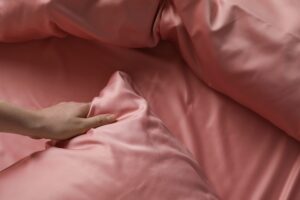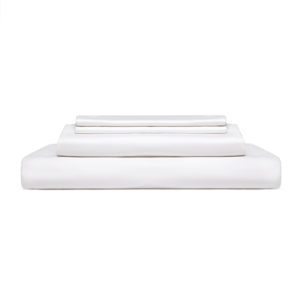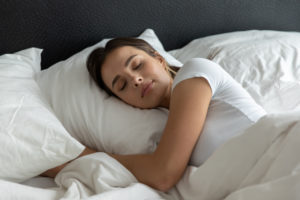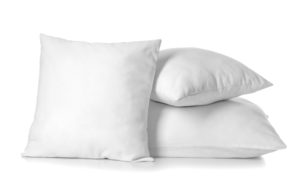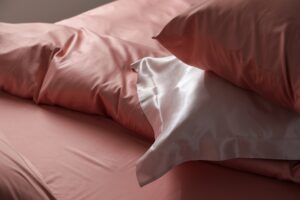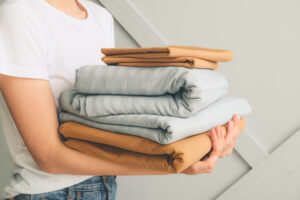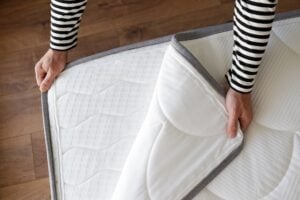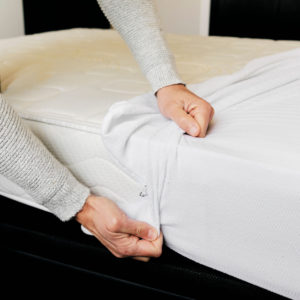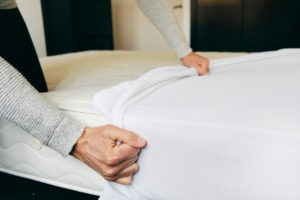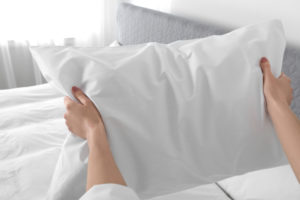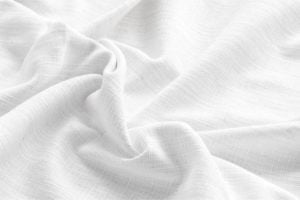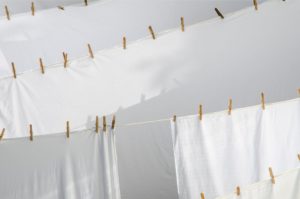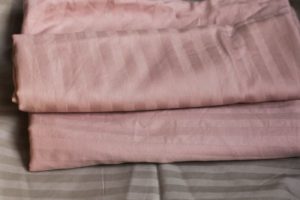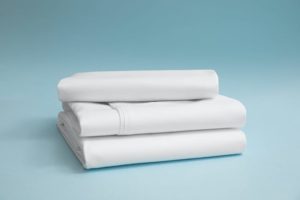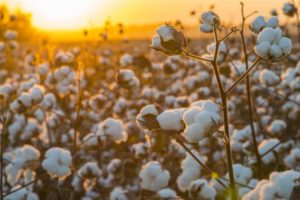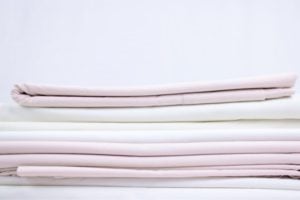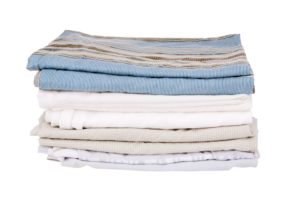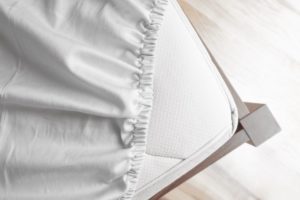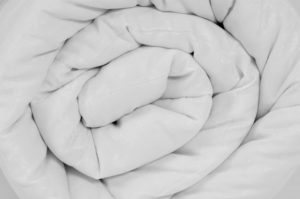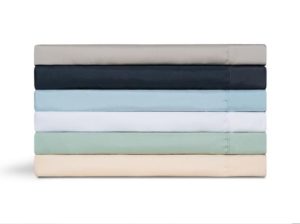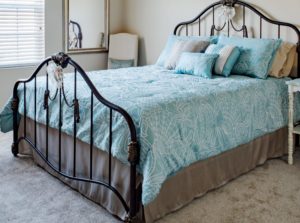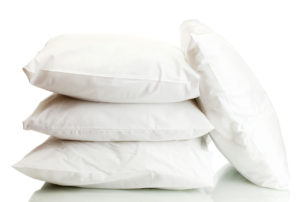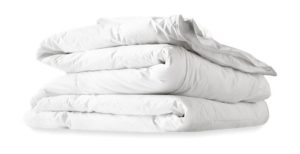What Is a Comforter?
A comforter is a popular bed covering similar to a thick, fluffy blanket. It is a single-piece unit composed of a fabric shell surrounding soft, warm fill. Comforters usually lie on top of a flat sheet or blanket. They are often included in bedding sets and come in a variety of styles.
Many shoppers confuse comforters and duvets. We’ll explain the difference between the two bedding products, as well as how they typically compare in areas like warmth, durability, and ease of cleaning. We’ll also discuss the various shell and fill materials of comforters and how they perform.
Comforters Explained
Multiple layers make comforters warmer than traditional blankets. Their outer shells typically consist of breathable material with a smooth, soft surface. However, fuzzy and other textured options are also widely available. The inner fill can be natural or synthetic material designed to insulate the sleeper. Patterned stitching helps hold the fill in place and prevent clumping.
A comforter’s shell and fill materials affect its performance and longevity. While natural materials tend to be more effective temperature regulators, synthetic alternatives may be easier to clean. People who enjoy warm, fluffy bedding generally prefer a comforter over a thinner covering, such as a quilt.
Comforters are an easy way to add warmth and style to create your ideal bedroom. When used with a top sheet, they don’t need to be washed as often as a duvet cover. Care requirements vary widely depending on the materials, so it’s important to check the manufacturer’s instructions.
What Are Comforters Made Of?
Comforters can be made of natural materials, synthetic materials, or a combination of both. Natural materials include cotton, wool, silk, feathers, and down. They are prized for their breathability and comfort. Synthetic materials, such as down alternatives, are usually made of polyester and may be easier to clean.
Rayon derived from bamboo or eucalyptus is semi-synthetic. The raw material comes from trees but requires extensive chemical processing to produce regenerated cellulose. The resulting material is typically smooth, breathable, and moisture-wicking.
Comforter Shells
Comforter shells are the fabric pouches that surround the fill and determine the outward appearance and feel. Understanding the specific kinds of shells can help you decide which is best for you.
Cotton Shells
- What It Is: Cotton is a natural plant fiber. It may be categorized as short-staple, long-staple, or extra-long staple depending on the length of the fibers.
- How It Feels: Shells that use longer-staple cotton varieties tend to be smooth, soft, and breathable. Feel also varies depending on the fabric’s weave. A percale shell is usually crisper and cooler, while a sateen shell is silkier and cozier.
- How It Performs: A cotton shell can improve the comforter’s airflow and simplify cleaning.
Silk Shells
- What It Is: Silk is a natural fiber made from the cocoons of silkworms and other insects. The fine silk threads are woven tightly together into fabric.
- How It Feels: This material is luxuriously smooth and cool to the touch. It can also feel slippery compared to other fabrics.
- How It Performs: Silk excels in temperature regulation, but its delicate nature requires extra care. Because of the material’s slippery texture, preventing overnight shifting may be more difficult.
Wool Shells
- What It Is: Wool is a natural, hair-like fiber that comes primarily from sheep.
- How It Feels: Comforters with wool shells can feel soft or rough depending on their quality and construction. They often feel similar to an especially heavy blanket.
- How It Performs: Although warm in winter, wool also wicks away moisture for good year-round temperature regulation. However, you must maintain it carefully to prevent shrinkage and matting.
Eucalyptus Shells
- What It Is: Fabrics labeled as eucalyptus or bamboo generally consist of rayon or lyocell made of processed wood pulp fibers.
- How It Feels: Eucalyptus- and bamboo-derived shells feel soft and silky, especially if the fabric has a sateen weave.
- How It Performs: Shells with eucalyptus- or bamboo-derived fabric are generally breathable, cool, moisture-wicking, and ideal for warmer climates. The smooth surface shouldn’t irritate sensitive skin.
Comforter Fills
A comforter’s fill material is the insulation, which plays a large role in its overall quality and performance. Because each type of fill is unique, we’ll take a closer look at the most popular options.
Down Fills
- What It Is: Down is the soft, fluffy underlayer of feathers that insulates the bodies of waterfowl. Most down fill comes from ducks or geese.
- How It Feels: Down comforters with a lower fill power tend to be light and breathable. Higher fill powers create warmer and heavier comforters.
- How It Performs: Because down is especially fluffy, it makes lighter and loftier comforters. Cleaning a down comforter requires extra care.
Down Alternative Fills
- What It Is: Down alternative is a synthetic material often made from polyester that imitates the fluffiness of down.
- How It Feels: While down alternative is often soft and warm, it generally doesn’t match down’s insulating capabilities. The fill quality and volume determine the breathability and warmth.
- How It Performs: While down alternative is not as durable as down, it is easy to clean and resistant to allergens.
Eucalyptus Fills
- What It Is: Eucalyptus fill consists of rayon or lyocell made from cellulose fibers derived from eucalyptus trees. Tencel is one of the most common brand names for this material.
- How It Feels: Comforters filled with rayon or lyocell derived from eucalyptus have a plush, down-like feel. The fill is an effective temperature regulator, wicking away moisture and heat.
- How It Performs: Eucalyptus-based rayon or lyocell comforters regulate temperatures to provide year-round comfort. They’re typically machine-washable.
Cotton Fills
- What It Is: Cotton is a natural plant fiber that is soft, breathable, and gentle on skin.
- How It Feels: Cotton-filled comforters tend to be soft, light, and breathable. They work well for hot sleepers and people who live in warm climates.
- How It Performs: Cotton isn’t as warm as many fill options, but it’s easy to clean and unlikely to trigger allergies.
Wool Fills
- What It Is: Wool is a natural fiber that is usually sheared from sheep. It acts as a natural insulator.
- How It Feels: Comforters with wool fill tend to be heavier and warmer, like a thick blanket. However, the material’s moisture-wicking and temperature-regulating properties help prevent overheating.
- How It Performs: Wool fill performs well in any climate, making it popular with sleepers who want extra weight without excessive heat. While comforters with wool fill are often machine-washable, you must take care to avoid damage.
Choosing the Right Comforter
To pick the best comforter, shoppers should consider factors like climate, price, quality, and aesthetic preferences.
Since comforters provide insulation, the right option for you should correspond to your climate and sleep temperature. Shell and fill materials can differ greatly in weight, warmth, and breathability. If you tend to sleep hot, a lighter, more breathable option can add coziness without as much warmth. Conversely, cold sleepers might prefer something heavier to retain their body heat.
Price can also be a differentiating factor. Comforters range from under $50 to over $500, so there’s something for nearly any budget. Bedding sets are often particularly affordable. However, some higher-priced comforters may ultimately be a better value if they have a more durable build. Shells with a higher thread count and sturdier stitching often hold up better to routine use.
Personal aesthetic preferences can also influence your satisfaction with a comforter. Comforters come in a variety of textures, patterns, and colors. With plenty of options available, you should be able to find a comforter that meets your needs and complements your decor.
What Is the Difference Between a Comforter vs. Duvet?
Although the terms duvet and comforter are often used interchangeably, a duvet’s design is distinguished by its removable cover.
A duvet is typically thicker, fluffier, and warmer than a comforter. Duvets are traditionally filled with down but can use other materials, such as down alternative, cotton, wool, or silk. They are usually slipped into a duvet cover that acts as an easy-to-clean, protective layer. Sleepers who prefer to forgo a flat sheet often use a duvet encased in a duvet cover.
Comforters are designed with more durable shells that don’t require an additional cover for protection. Since comforters usually aren’t as thick or warm as duvets, sleepers often use them with blankets during winter.
Both duvets and comforters act as warm bed coverings that bring style to the bedroom. Duvets are more common in Europe, while comforters are popular in the United States.
Comforter vs. Duvet
| Category | Comforter | Duvet |
|---|---|---|
| Durability | A comforter’s durability depends on its materials and how you care for it. Without a separate cover, it is more likely to get stained or wear out from repeated washing. | A duvet’s cover can prolong its life by preventing damage and reducing the need for regular cleaning. Therefore, a duvet’s durability depends primarily on its materials and construction. |
| Warmth & Loft | Comforters tend to be thinner and cooler than duvets, which can make them more suitable for year-round use. Some people may need to use an additional blanket for warmth in the winter. | Duvets are typically thicker and warmer than comforters. Their loft depends on the fill materials and maintenance. Over time, a duvet could flatten. You can restore the loft with occasional fluffing. |
| Cost | Due to their varying materials, comforters have a wide price range. They’re usually most affordable when part of a bedding set. Individual comforters with high-quality materials are more expensive. | Although traditional down duvets are usually relatively expensive, shoppers can find more affordable options with different fill materials. A duvet cover is typically an additional expense. |
| Style | Comforters come in an array of colors and patterns for all ages and aesthetic preferences. | Duvet covers are available in a large variety of styles, giving duvet owners the option to change the look of their bedding without having to replace the duvet itself. |
| Cleaning & Care | A comforter’s materials determine its care instructions. Many are machine-washable, but they can be bulky and difficult to launder at home. Some owners prefer to use a washable duvet cover with their comforter for easier cleaning. | Duvet care varies depending on the materials and construction. Some duvets are machine-washable, while others call for dry-cleaning or spot-treatment. Duvet covers are usually machine-washable and can limit the need to clean the duvet itself. |

Still have questions? Ask our community!
Join our Sleep Care Community — a trusted hub of sleep health professionals, product specialists, and people just like you. Whether you need expert sleep advice for your insomnia or you’re searching for the perfect mattress, we’ve got you covered. Get personalized guidance from the experts who know sleep best.

